March 1 is a veritable holiday for many anglers hoping to land their first keeper on the first day of state park trout season. And why not? Bennett Spring, Roaring River and Montauk — three of Missouri’s four trout parks — are two hours or less from Springfield, making them a short trek for locals any time of year.
If you already fish at trout parks, you know how they work. But if you’ve never visited one and don’t know what to expect for you or your family, here’s help.
We’ll guide you through trout park regulations overall and share details about the three parks nearest to Springfield. Each has its own character, and all are worth visiting (even if you don’t fish).
Why do we care? Because Missourians are lucky to have four state-funded trout parks, and we Ozarkers are lucky to have three within easy reach. Everything you need is there, including overnight lodging, says Tom Whelan, hatchery manager for Montauk State Park.
Because they are stocked with hatchery-raised trout, the parks help make fishing successful for kids or people starting out (and experienced anglers, too).
“We can’t guarantee that you will catch fish but we’re trying to make it a high probability that you will,” Whelan said. “The parks are a great place, first, for people to learn how to do any kind of fishing. And your trout parks — well, we’re kind of catering to families.”
Not only do trout parks expose people to fishing, but they also cultivate a lifelong love for the sport.
“In years to come, (novices) become your die-hard fishermen and are tying their own flies,” Whelan said.
And you don’t have to invest a lot of money to start trout fishing, he says.
“You can go to Walmart and buy a $25 to $30 ultralight (rod), get a few rooster tails that let you fish anywhere in the park — and go fish! And with your $4 trout tag — I mean, where else can you spend $4 and stay all day there?”
First things first: Get a Missouri fishing permit (click to expand)
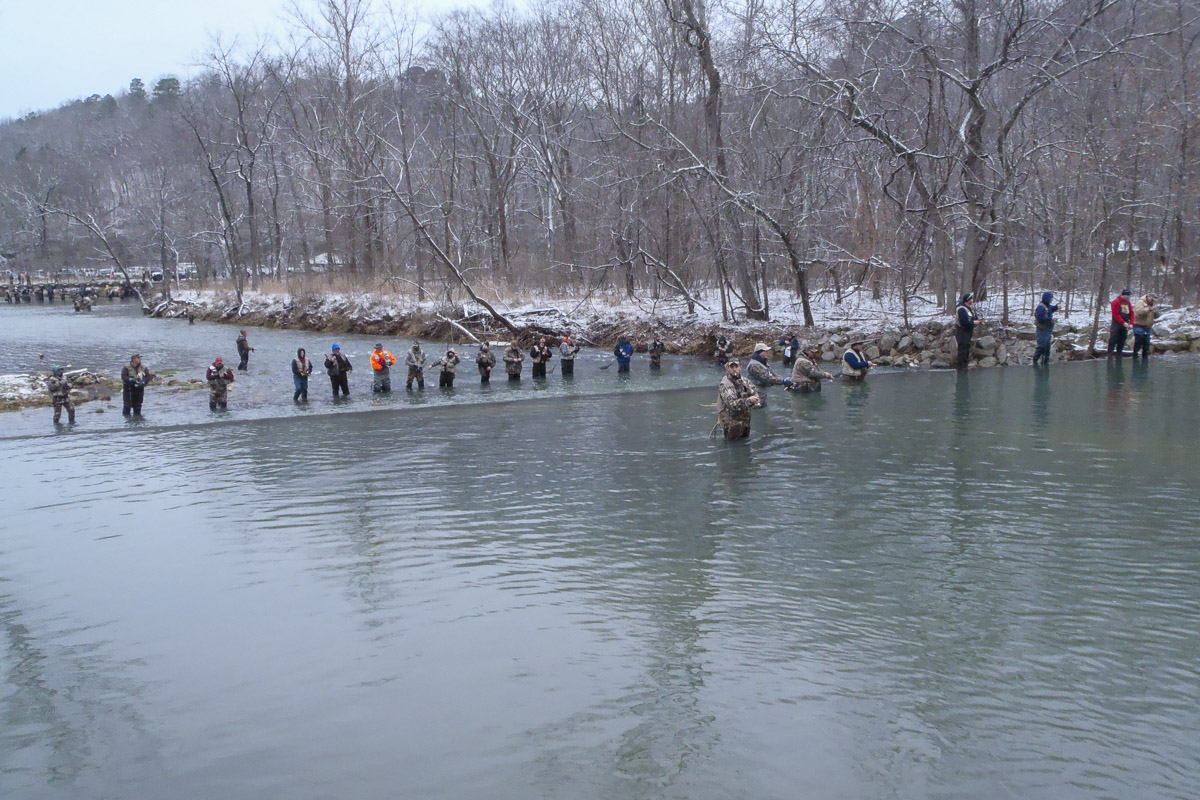
If you are new to fishing — or new to the state — your first step is to get a Missouri fishing permit which costs $12 per year, renewable annually. (Ages 15 and younger or 65 and older are exempt from needing a general fishing permit.)
You can get one online through the MDC. You can also get them at many sporting goods stores and Walmart Supercenters, or check with a state trout park concessionaire.
For possession of trout outside of a trout park and for fishing in the upper area of Lake Taneycomo, anglers (even the age-exempt) also need an annual trout permit ($10, or $5 for ages 15 and younger). You also need one to fish in trout parks during winter months.
But you do not need a trout permit to fish inside a trout park between March 1 and Oct. 31, when you must instead purchase a daily trout tag. (Read more about daily trout tags in this guide.)
Pro tip: Keep your fishing license and legal identification together on your person while fishing at any public lake or stream. (Yes, rangers do ask to see them.)
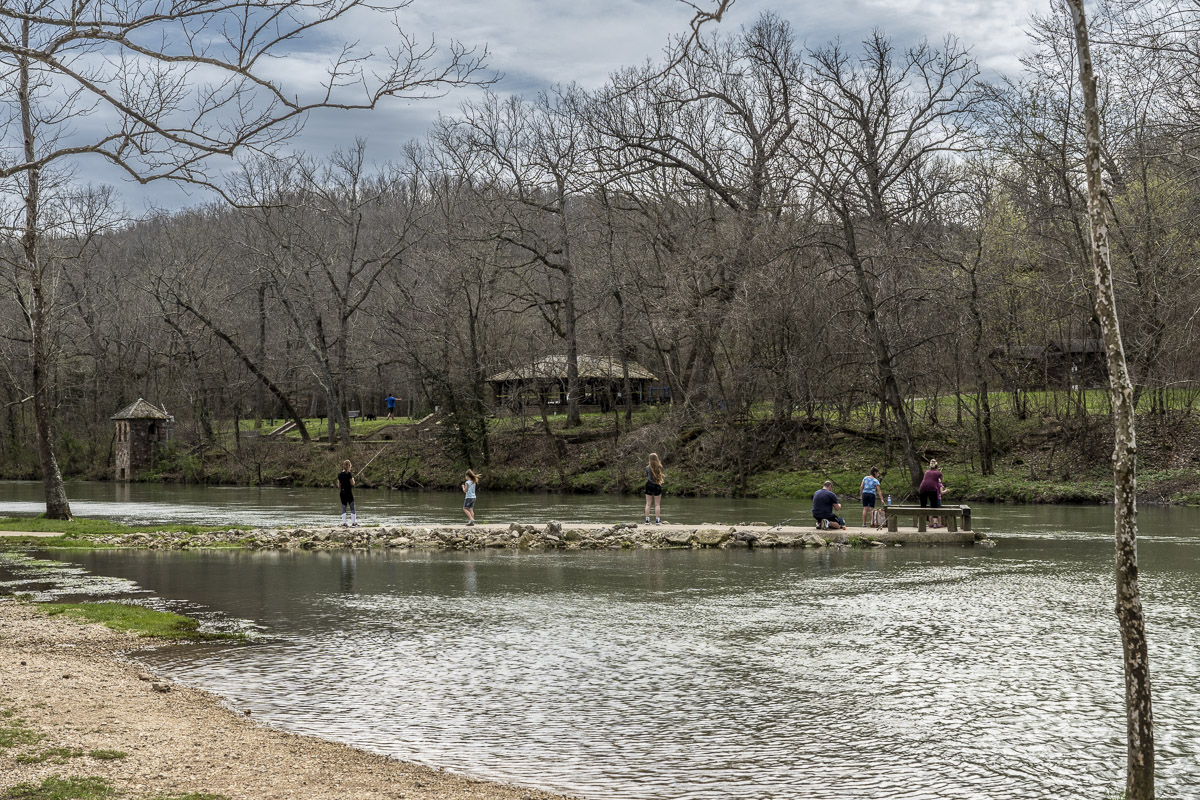
Trout park 101: A basic guide
If you already know how trout parks work, jump ahead to learn about a Missouri park you haven’t visited yet. Keep reading here to learn about regulations overall.
March 1-Oct. 31 is considered in-season fishing, with possession, at trout parks. That means you can keep your catch instead of releasing it, as required during winter months. This guide covers the spring-to-fall trout park season. (To learn about winter fishing, read this story.)
When fishing during this season, there are three primary rules to follow: you must purchase a daily trout tag, you must only fish between hours set by the Missouri Department of Conservation and you must follow possession limitations.
Why the regulations? Because from March through October, streams at these parks are stocked each evening with trout raised in hatcheries. That’s why so many folks get on the river before the morning horn sounds, with casting arm at the ready: they want to be the first to lure fresh, hungry trout.
All three parks covered in this story have their own hatcheries. And each has its own zoning regulations for allowable bait or lures in various fishing areas. We share a guide for each park in the sections below.
Learn more about tags, fishing hours and possession (click to expand)
Trout tags
Purchase your daily tag inside each park’s general store during operating hours on the day you plan to fish. Or you can get your next day’s tag after the evening horn sounds on the day prior. You must sign your tag, which is date-stamped, and wear it displayed prominently on your person. (Pins are available with tags.) The most common places anglers pin a tag are the back of a hat or vest.
The cost for tags at Bennett Spring, Roaring River and Montauk state parks is $4 $5 per tag, or $3 for ages 15 and younger. (We don’t explore Meramec Spring Park in this story, but daily tags there are $5 and $3.) Each day’s trout tag sales help fund the hatcheries and contribute to historical data used daily by managers to determine how many trout to stock each day of the season.
Fishing hours
Trout parks follow regulated fishing hours set by the MDC. These hours change as days lengthen and then shorten. From March 1 to 11 (Daylight Standard Time), hours are 6:30 a.m.-6 p.m.; then 7:30 a.m.-7 p.m. starting March 12 (Daylight Savings Time) and for the rest of the month. Hours change again on the first day of April, May, June (for June and July), August, September and October.
The park sounds a horn (some call it “the bell”) to signal the start and end of that day’s fishing hours. Pro tip: Don’t even think about casting before the morning horn or after the evening horn. Not only could you be fined, it’s simply not done.
Trout park monthly fishing hours (click to expand)
March 1-11: 6:30 a.m.-6 p.m.
March 12-31: 7:30 a.m.-7 p.m.
April 1-30: 7 a.m.-7:30 p.m.
May 1-31: 6:30 a.m.-8:15 p.m.
June 1-July 31: 6:30 a.m.-8:30 p.m.
Aug. 1-31: 7 a.m.-8 p.m.
Sept. 1-30: 7:30 a.m.-7:15 p.m.
Oct. 1-31: 7:30 a.m.-6:30 p.m.

Possession of trout
In addition to tags and hours, the most important regulation to follow is the daily and total number of trout you are allowed to keep. The daily limit is four trout per person at the three parks in this story; the total limit at any given time is 10 eight in possession per person. Anglers must also keep their own trout on a personally labeled stringer. (Note: There is no size limit for keeping rainbow trout, but brown trout must be at least 15 inches to keep.)
For more detailed regulations, visit this MDC page.
Trout fishing equipment, lures and bait
The Missouri Department of Conservation has a robust website with educational tips and information for catching trout. That includes a list of recommended equipment that can be purchased at a local outdoor store or park stores. Among the MDC’s recommendations:
- A hand net to scoop the trout as you reel it in
- A stringer labeled with your name and address
- Pointy-nosed hemostats to remove swallowed hooks (anglers often attach these to a vest)
- Waders or waterproof boots if you want to get into the water where able
- Fishing vest to carry small essentials (plus a small box with extra hooks, weights and lures)
- Polarized sunglasses
- Rod and reel — a basic spin-cast rod and reel works just fine but anglers also use ultra-light rods, spinning reels and fly rods
- Bait, flies or lures (dough bait is commonly used in allowable zones; flies only are allowed in some zones; flies and artificial lures, including soft worms, can be used in other zones.
For more information about trout fishing, visit MDC’s Trout Fishing Tips page.
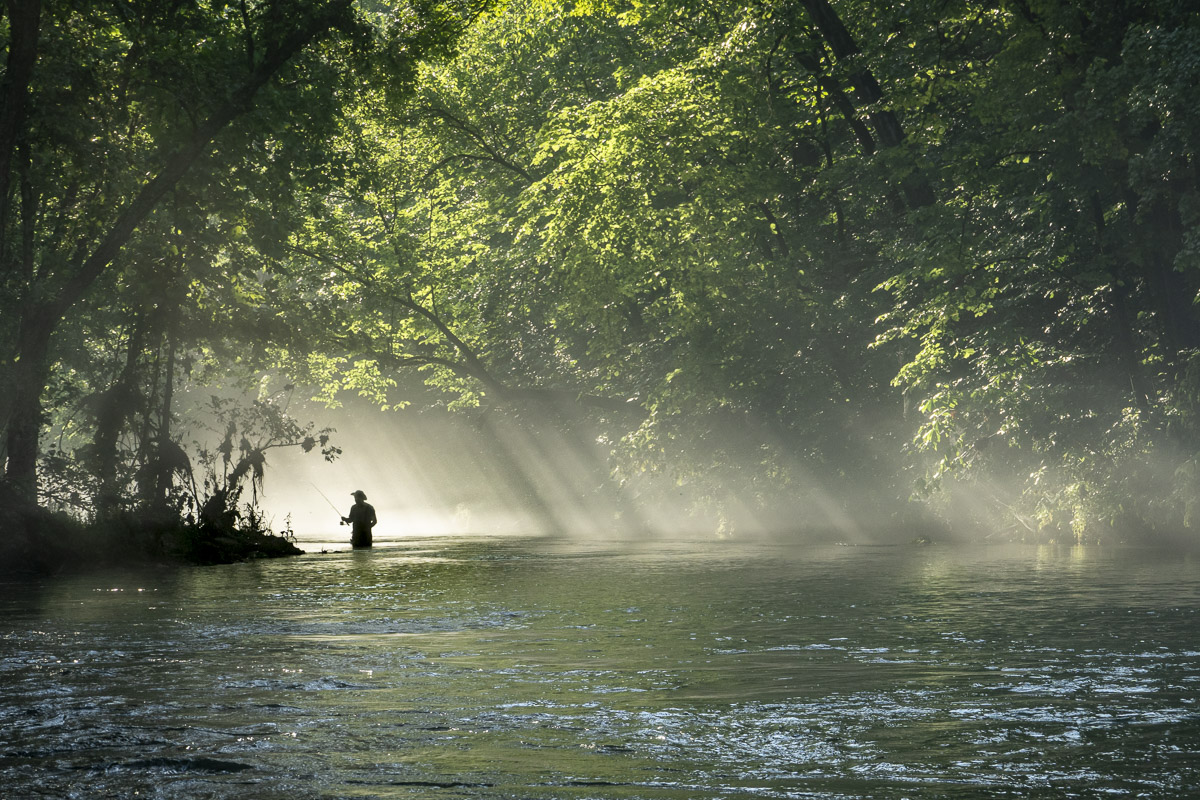
Bennett Spring State Park
The closest trout park to Springfield at just over an hour away, Bennett Spring State Park is a favorite of many Ozarkers. The beautiful valley park is named for the spring that gushes 100 million gallons of water daily into a blue-green pond that swiftly flows into a spring branch. The branch snakes through the park, roughly 3,300 acres, and empties into the Niangua, a popular floating river.
You’ll find anglers wade fishing and bank fishing all around this park. The stream is divided into three fishing zones, which regulate what kind of bait or lures an angler can use. In Zone 1, from the spring to the dam, only artificial flies are permitted. Zone 2 runs from the dam, under the stone arched bridge to the whistle bridge. In this area near the hatchery, park office, store and lodge, only flies and artificial lures are permitted. In Zone 3, from the whistle bridge to the Niangua River, no artificial lures or flies are allowed. Here, anglers can only use natural and scented bait (like dough bait) and unscented soft plastic bait. Zone maps are available in the park.
One park landmark is the 1935 Gauge House near the spring. Built to predict flooding, now it’s a scenic element. Another is the arched stone bridge near the dam. The park also includes a hatchery, a park store (where you’ll get tags) and a rustic dining lodge built in the 1930s. Overnight visitors can rent cabins or secure camping spots through park concessionaires. In addition to fishing, the park is ideal for picnics, hiking, family gatherings and as a home base for floating the Niangua.
Like all the trout parks, Bennett has a hatchery. Renovation work begins in 2023, which means other state hatcheries will supplement trout for daily stocking.
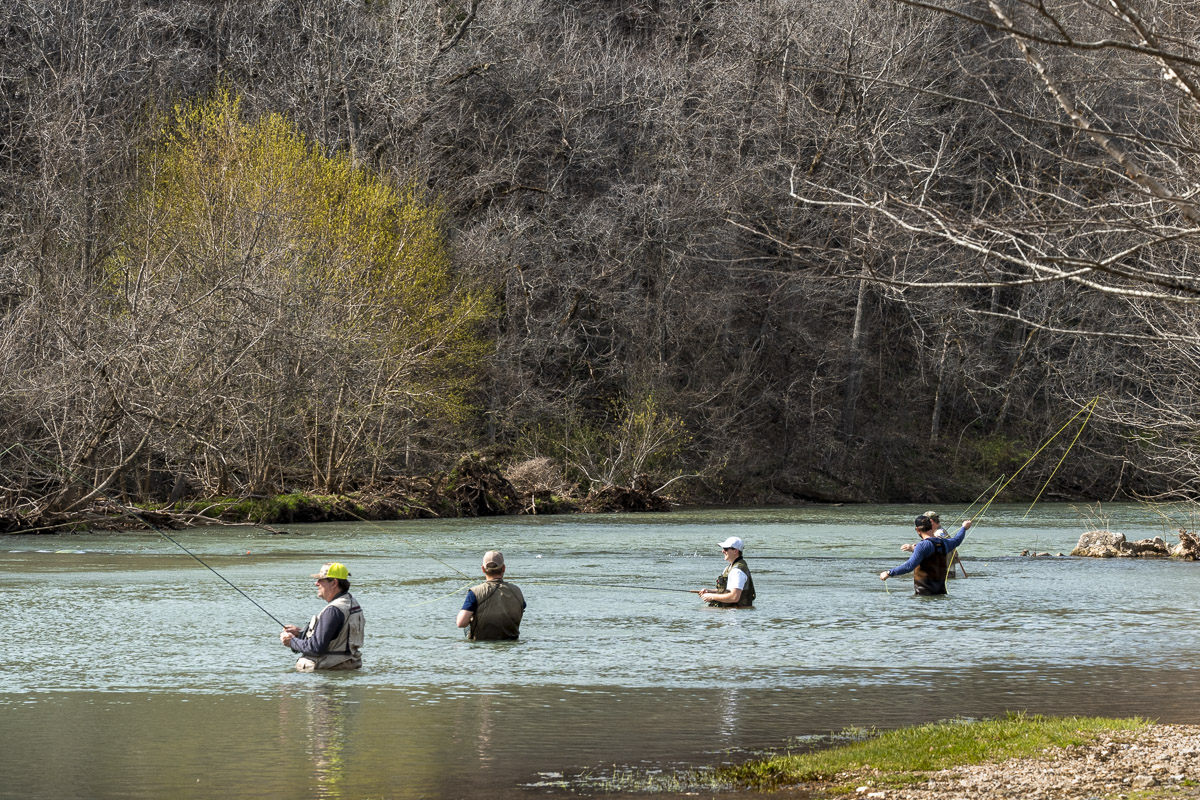
Bennet Spring State Park
Where: 60 miles northeast of Springfield; 26250 MO-64A, Lebanon
Drive time: 70 minutes
Also features: Spring, hiking trails, campgrounds, cabins, store, lodge, dining, nature center, hatchery, accessible fishing areas
Concessionaire: bennettspringstatepark.org, 417-532-4307
For more information: Visit the Missouri State Parks website and check out the park map.
Roaring River State Park
Roaring River is a rugged trout park tucked into a deep gorge with beautiful bluffs and natural rock features, which makes it ideal for hiking in addition to fishing. It’s a meandering park with distinct fishing areas divided into three zones. Most anglers bank fish in this park, but there are a few areas where wading also works.
Besides its seven trails and notable bluffs, Roaring River’s fishing stream is distinguished by its low natural dams which create pretty cascades punctuated by deep pools. The park is also noted for its deep cave spring, located near the hatchery, which flows into a blue-green pool with dozens of large, safe-from-anglers trout which are fun for kids to feed. (Hike the short but steep Deer Leap Trail for a great view of the pool and park from an overlook.) The spring emits 20 million gallons of water each day and is Missouri’s deepest spring with a depth of more than 470 feet.
Like Bennett Spring, the park is divided into fishing zones, based on permitted lures and bait. Zone 1, which goes from the hatchery to the mouth of Dry Hollow Creek near the main road, is a bluff-protected stretch of water flowing from the spring. This section only allows artificial lures, soft plastics and flies. Zone 2, from Dry Hollow Creek to the old dam near Campground 3, allows flies only. Zone 3, from the old dam to the park boundary, allows artificial lures, flies, soft plastics and natural baits (like dough bait).
One unique aspect of Roaring River is that part of Zone 2, where you can wade fish, only allows for catch-and-release and it also allows for swimming! In addition, this park has a swimming pool near Campground 1 open during the summer months. The park is ideal for family camping, hiking and easy trail walking. And for anglers who prefer comfort over rustic cabins or camping, there’s a modern lodge with a restaurant and conference center.
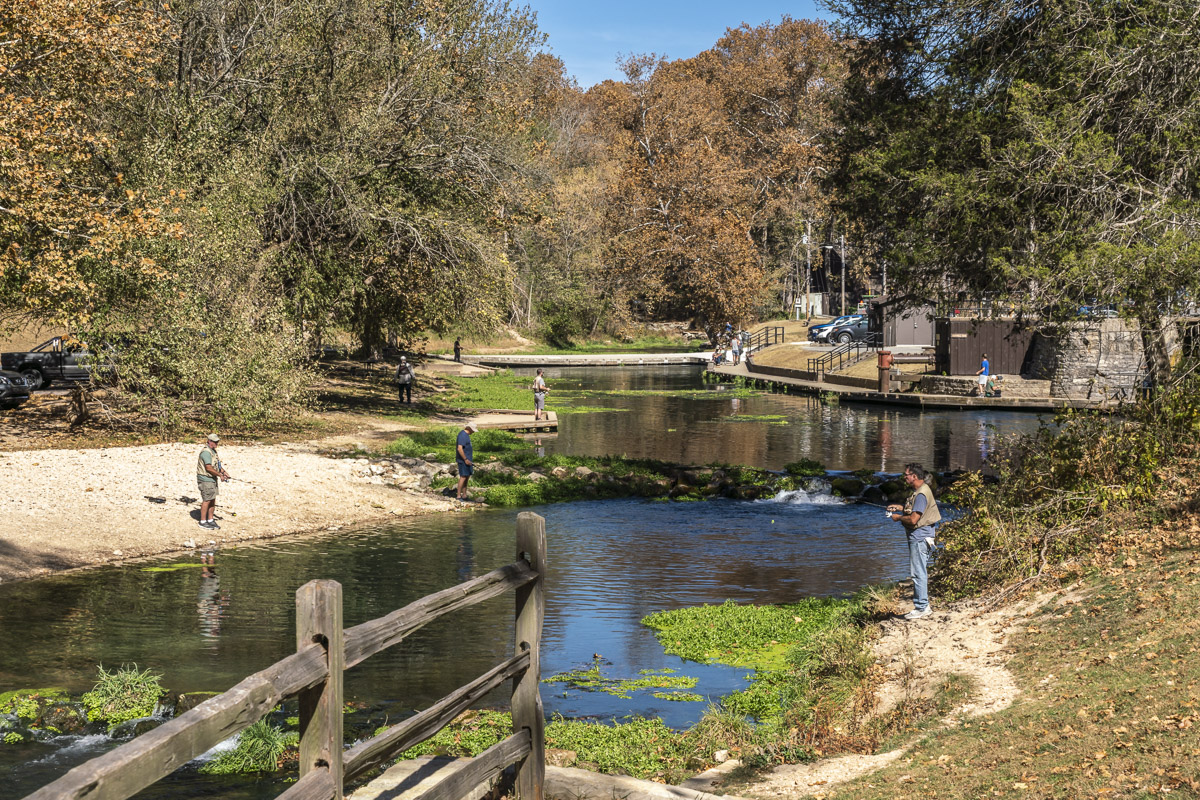
Roaring River State Park
Where: 75 miles southwest of Springfield; 12716 Farm Rd 2239, Cassville
Drive time: 90 minutes
Also features: Spring, hiking trails, campgrounds, cabins, store, rustic CCC lodge, dining, hatchery, playground, swimming pool, shelters, nature center, accessible fishing areas, Emory Melton Inn and Conference Center
Call: 417-847-2539 for information; 877-422-6766 for camping reservations
For more information: Visit the Missouri State Parks website. You can also view the park map and read park history.
Montauk State Park
While Montauk State Park is the farthest featured park in this guide with a two-hour drive, many families plan annual stays. The park is distinguished for containing the Current River headwaters. Several springs in the park combine with Pigeon Creek to add more than 40 million gallons of water daily to the Current as it snakes around the park, behind the lodge, past the campgrounds and beyond park boundaries as it grows wide enough to float. Tucked into a cool, green valley, the park has lots of wooded areas to provide shade for anglers, but with enough grassy spaces for family play.
Like other parks, sections of Pigeon Creek and the Current River are regulated for lures or bait. Signs throughout the park let anglers know what’s allowed. (The online fishing page of the park’s website doesn’t refer to “zones.” See this map for color-coded fishing areas.)
As a general guide: There are sections near the old hatchery and a spring pond (Montauk Lake) that are catch-and-release only using flies. The section of the Spring Branch where people bank fish (roughly from the old hatchery and along the road as you enter the park) allows for artificial lures and natural bait (like dough bait). That section flows into Pigeon Creek near the bridge, forming the Current. The area of Pigeon Creek below the dam, as it combines with the Spring Branch and continues as the Current River through the rest of the park, allows for artificial lures and natural bait. However, only flies are allowed upriver from the dam (the blue section of that map), and you’ll see many whipping lines of fly rods here.
This park offers many amenities pleasing to families. It’s easy to ride bikes and it features the historic Montauk Mill, a landmark next to the hatchery. The rustic lodge and store (where you buy tags) features an old-fashioned soda bar and a full-service restaurant. To stay in the park, options include four camping areas, basic lodge motel rooms and cabins of various sizes. There are lots of places to explore, several playgrounds and shelters, plus a few trails. (Although Montauk doesn’t have a robust trail system like Roaring River and Bennett Spring. You would not come to this park just to hike.)
This park is also a great base camp for other adventures, including floating the Current River and exploring springs and trails in the area around Eminence, about an hour away.
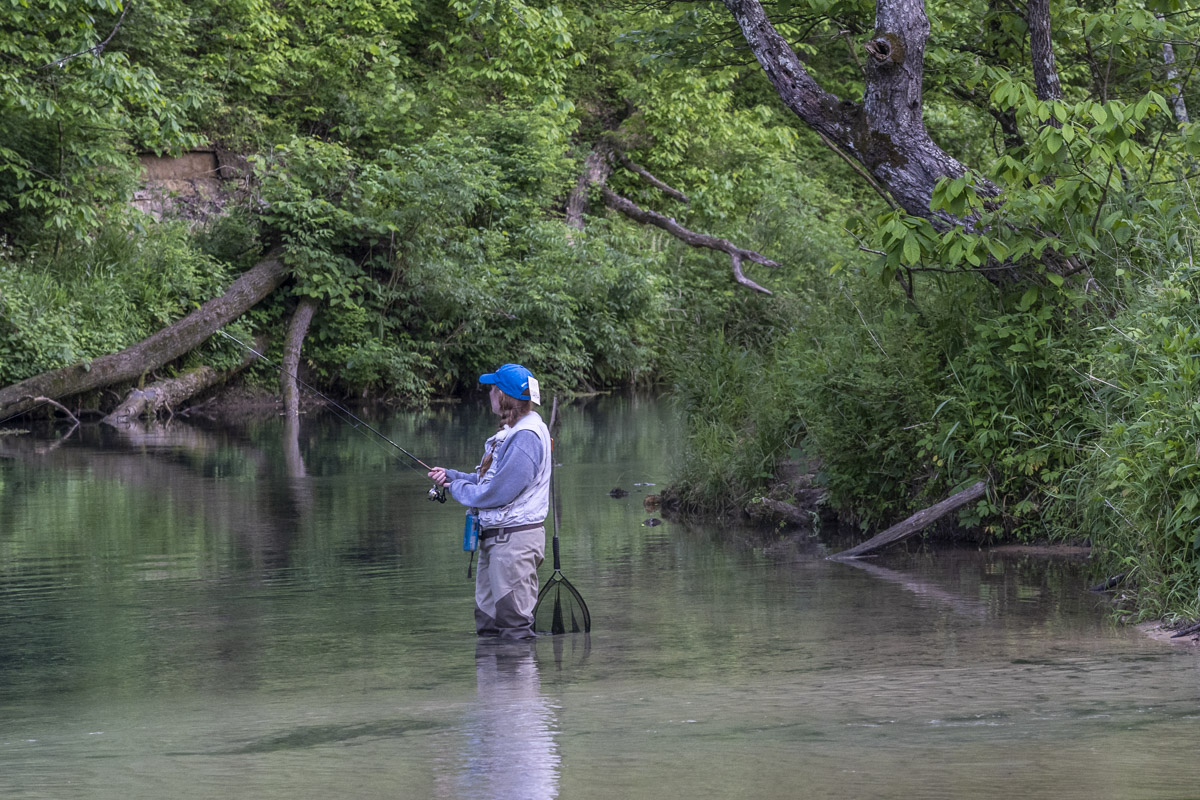
Montauk State Park
Where: 120 miles northeast of Springfield, 420 County Rd 6670, Salem
Drive time: 2 hours, 10 minutes
Also features: Old mill, springs, lake, trails, campgrounds, cabins, store, lodge, dining, hatchery, accessible fishing areas, playgrounds, shelters
Montauk Lodge: montauklodge.com, 573-548-2434
For more information: Visit the Missouri State Parks website and view the Montauk State Park map


